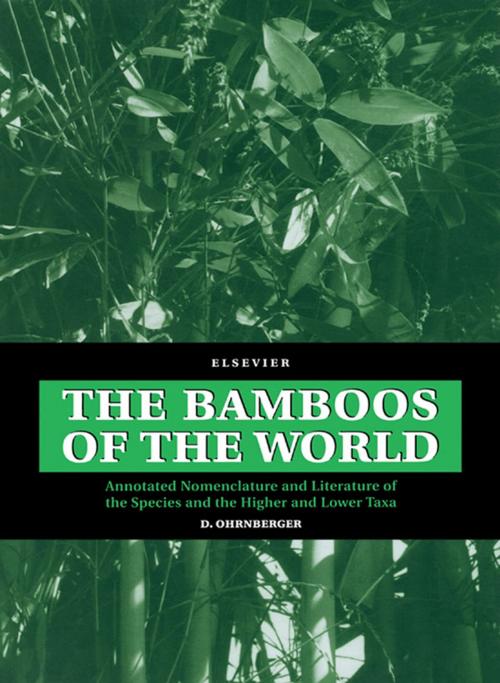The Bamboos of the World
Annotated Nomenclature and Literature of the Species and the Higher and Lower Taxa
Nonfiction, Science & Nature, Science, Biological Sciences, Botany, Technology, Agriculture & Animal Husbandry, Business & Finance| Author: | D. Ohrnberger | ISBN: | 9780080542386 |
| Publisher: | Elsevier Science | Publication: | January 29, 1999 |
| Imprint: | Elsevier Science | Language: | English |
| Author: | D. Ohrnberger |
| ISBN: | 9780080542386 |
| Publisher: | Elsevier Science |
| Publication: | January 29, 1999 |
| Imprint: | Elsevier Science |
| Language: | English |
Bamboos constitute one of a few select categories of plants which are taxonomically related, very rich in species and of vital economic and ecological importance. Since the early 20th century the accepted number of species of bamboos, world wide, has tripled. However, until now information was scattered through numerous, often not easily available publications.
The Bamboos of the World, is the first comprehensive (taxonomic as well as horticultural) reference work that provides basic information on bamboos world wide, whether they are wild or cultivated, well-known or rather unknown. The work, based on bamboo literature, facilitates access to further data by citation and a comprehensive bibliography. Among the main data included are botanical names with synonyms, and geographical distribution of genera and species, varieties with their distinctive characters, common bamboo names, plant introductions to the West, plant size and uses. The distribution of genera is mapped.
The Bamboos of the World presents a wealth of essential information in an accessible and structured manner. It gives the opportunity to check under what names, and where, relevant information on any bamboo can be found. For the researcher with management and development interests it provides a convenient means of basing bamboo resource on a sound understanding of generic and species relationships, with names that appear in earlier literature put into context. The work should prove to be invaluable for those interested in the morphology, taxonomy, distribution and cultivation of bamboos. It should support botanical, forestry, horticultural and ecological research, training and resource management.
Bamboos constitute one of a few select categories of plants which are taxonomically related, very rich in species and of vital economic and ecological importance. Since the early 20th century the accepted number of species of bamboos, world wide, has tripled. However, until now information was scattered through numerous, often not easily available publications.
The Bamboos of the World, is the first comprehensive (taxonomic as well as horticultural) reference work that provides basic information on bamboos world wide, whether they are wild or cultivated, well-known or rather unknown. The work, based on bamboo literature, facilitates access to further data by citation and a comprehensive bibliography. Among the main data included are botanical names with synonyms, and geographical distribution of genera and species, varieties with their distinctive characters, common bamboo names, plant introductions to the West, plant size and uses. The distribution of genera is mapped.
The Bamboos of the World presents a wealth of essential information in an accessible and structured manner. It gives the opportunity to check under what names, and where, relevant information on any bamboo can be found. For the researcher with management and development interests it provides a convenient means of basing bamboo resource on a sound understanding of generic and species relationships, with names that appear in earlier literature put into context. The work should prove to be invaluable for those interested in the morphology, taxonomy, distribution and cultivation of bamboos. It should support botanical, forestry, horticultural and ecological research, training and resource management.















